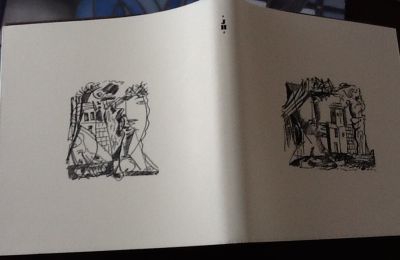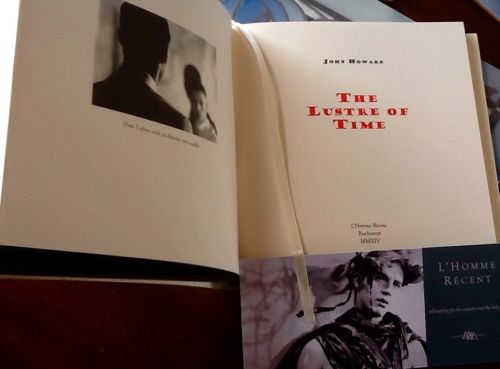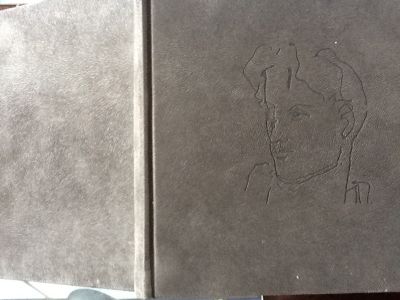The Lustre of Time
I have just received this book as purchased from its publisher…



THE LUSTRE OF TIME by John Howard
Published by L’Homme Récent
Bucharest MMXIV
My previous reviews of this publisher’s many books HERE
I intend to real-time review this book in the comment stream below as and when I happen to read it…



THE LUSTRE OF TIME by John Howard
Published by L’Homme Récent
Bucharest MMXIV
My previous reviews of this publisher’s many books HERE
I intend to real-time review this book in the comment stream below as and when I happen to read it…
Filed under john howard

Pages 7 – 18
“Luca had quickly realised that his room must be one of the few places in the city from which it was not possible to see either of its two hills.”
Ex Professor of Architecture, Dr Cristian Luca lives in John Howard’s Transylvanian ‘genius loci’ of Steaua de Munte, Luca’s life, professional and marital, having been down-altered by the end of the Second World War, as we are engagingly pulled into his life, his backhanders, his seeming satisfaction with a simple gardening business. Future the only certainty. Future like a wall through which he needs to turn lustrous in order to interpenetrate its molecules…?
“…an alternate present outcome.”
This is a deceptively plain-spoken text, a complexly entranced and entrancing one, full of regret and hope, as the history of Romania, ‘blood and sighs’, is echoed by its collectable postage stamps and walls …. and Luca’s own personal history.
Objects to carry other objects are objects themselves, as Luca meanders through his future while retrofixed by these objects into the past. The text is like a cloying dream radiating between atomicity and substance, radiating between the book’s covers themselves as lustrous walls (to prevent it slipping into ebook atomicity?)
Steauacity and its walls turned into a museum of itself but outside itself. I haven’t even covered half the ground of these pages.
“…there always seemed to be an unspoken accord to ensure that what was required to remain within those panelled walls did in fact do so.”
The rarefied nature of the plot and style together with the actual unwritten accord of this very book’s secret passages within its own stiffened and lustred walls makes the reader need (or at least it does me) to eke out and savour the act of physical page-lifting and page-turning as well as the richness of the text it contains, a text that will remain upon your cerebral palate, layer upon layer. Here Luca’s hopes are lifted then lowered by fears of conspiracy and of the changing history around him, changes that make the very walls change their names to suit acceptability, say, into Building X from Building Y. With ‘bulky balconies’ or ‘low balcony’, none seem yet high enough to see the whole map of this book. The view of people, too. And self. “…the confident strider was another man at another time – not him, there and then, not the reclusive gardener.” Black and white photographs turned into black and white text, this tracing of future onto past’s shape.
“He makes the sketch to reassure himself that he can still draw – that this skill hasn’t deserted him, even as he spends his days in another form of creation, that of drawing food from the soil.”
An ex-architect’s sketch…and it seems appropriate that, at a point where the narration’s active story-telling takes over from its more Steaua-ically passive spirituality of concrete, Luca manages to stop vegetables and fruit accidentally rolling down a building’s stairs as a sort of romantic chat-up line in retrospect.
“Close up, the photograph dissolved into black and white smears, shapes expanding out of view and into minuscule points in endless shades of grey.”
…likewise there is a tantalising sense that there are connections (some potentially stronger than others) between this book and the John Howard works I’ve previously read. Not that you need to have read them to appreciate this discrete work, a work of disguise against one’s own political or academic ‘celebrity’ and territorial or racial innuendo against the backdrop of the history that runs through the audit trail of Luca’s life like words through a stick of rock, although not exactly rock but the concrete and brick that make walls in architecture
“Soil and stones and smashed bricks and lumps of concrete: they all flayed me.”
I am beginning to believe that this is the author’s core masterpiece to date, but that is not to take anything away from the previous works. This seems to me to be a Large Hadron Collider of the soul as well as the soil. Of hill and embedded grave. Of the moving feast that is history, too. Of moving maps and soldiers of old or new frontiers as emerging states, some fighters in love with their perhaps suicidal cause, some in love with each other. Misguided, perhaps, and we fear they stand at the top of each set of wall-enclosed stairways that we are still ascending for good or ill.
“…but ultimately we are all one with the earth,…” … Or actually inside it, at its core, like Jules Verne or Nemonymous Night? Cultivating one’s garden, like Voltaire?
“Every room, every wall, must surely have absorbed the energy – all the different energies – that I and my wife and her family and our friends and acquaintances flung out at them during our discussions, arguments, debates, parties, encounters.”
Incredibly premonitory, in hindsight, if I say so myself, that my comment above in earlier real-time reading of this book mentions a ‘moving feast’ of history. And in this section, with stars as illuminated Cern particles joined to windows, this moving feast surely comes home to roost – in the very building Luca once shared with his wife, it seems. This is an astonishing piece of writing that sheds walls as well as cakes on Romanian history, even including the Bela Lugosi aspect of this part of Romania! Classical music, too, desanctified by crass behaviour…literature’s ultimate ‘blow-out’ as well as photographic ‘blow-up’.
“…colliding with the upper balconies…”
I don’t say this lightly, nor heavily, but this work is a genuine literary masterpiece as well as story-telling feat, and I can’t believe that only 85 people (and those to whom they lend or sell this book) will have the chance to read it. For me, “So much to examine, but never enough fully absorbed and understood, with significances noted and correlated and connections made.”
It’s like history talking to history on the highest balcony and, the next moment, talking to each other like Higgs boson inside a biscuit tin! It depicts a Third Reich reconstruction into a solid unavoidable future of blank white buildings and minds then overridden by an open-ended airy lustre of spirituality or gardening. It is all the famous architects rolled into one … or none. It is the bust of a head, in both senses of bust. “…master of architectural space, and wielder of matter,…”